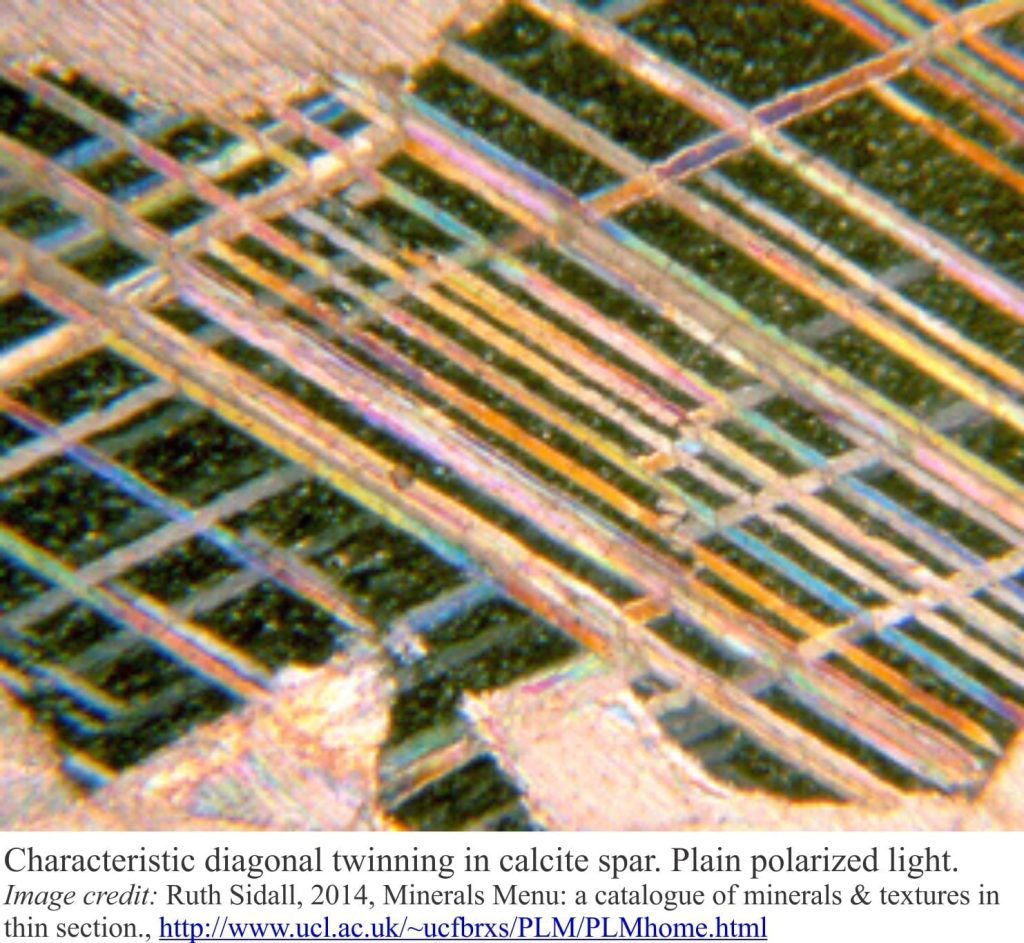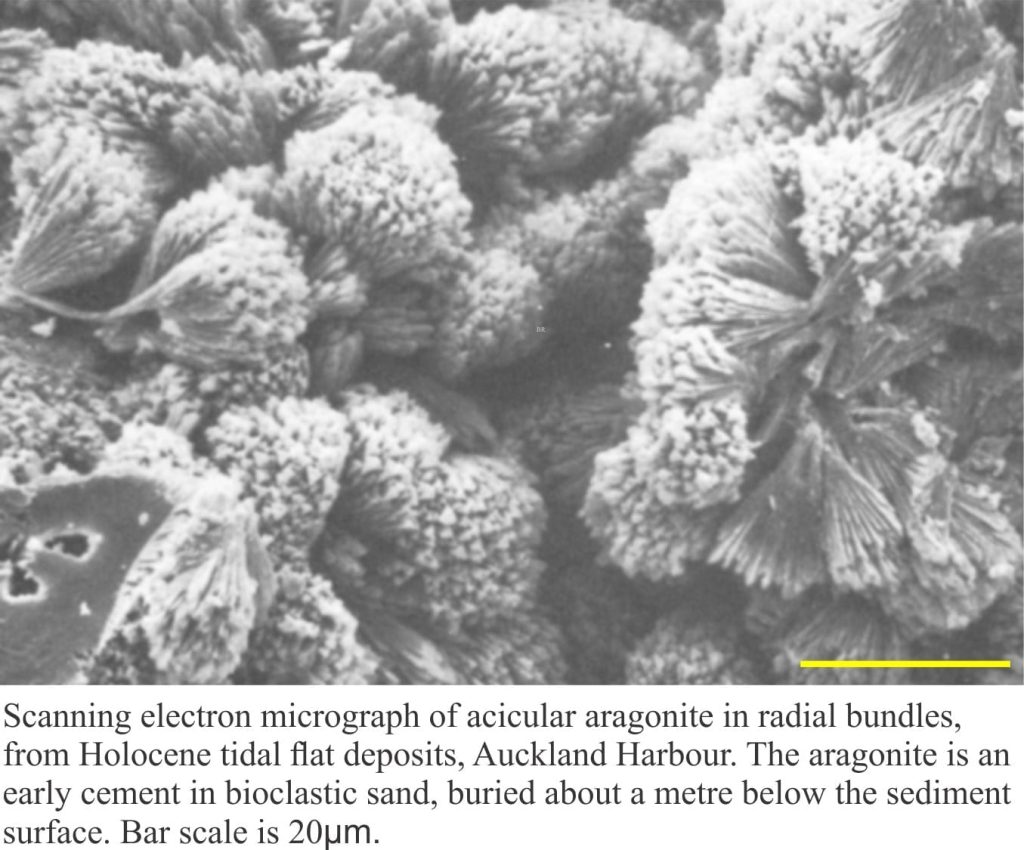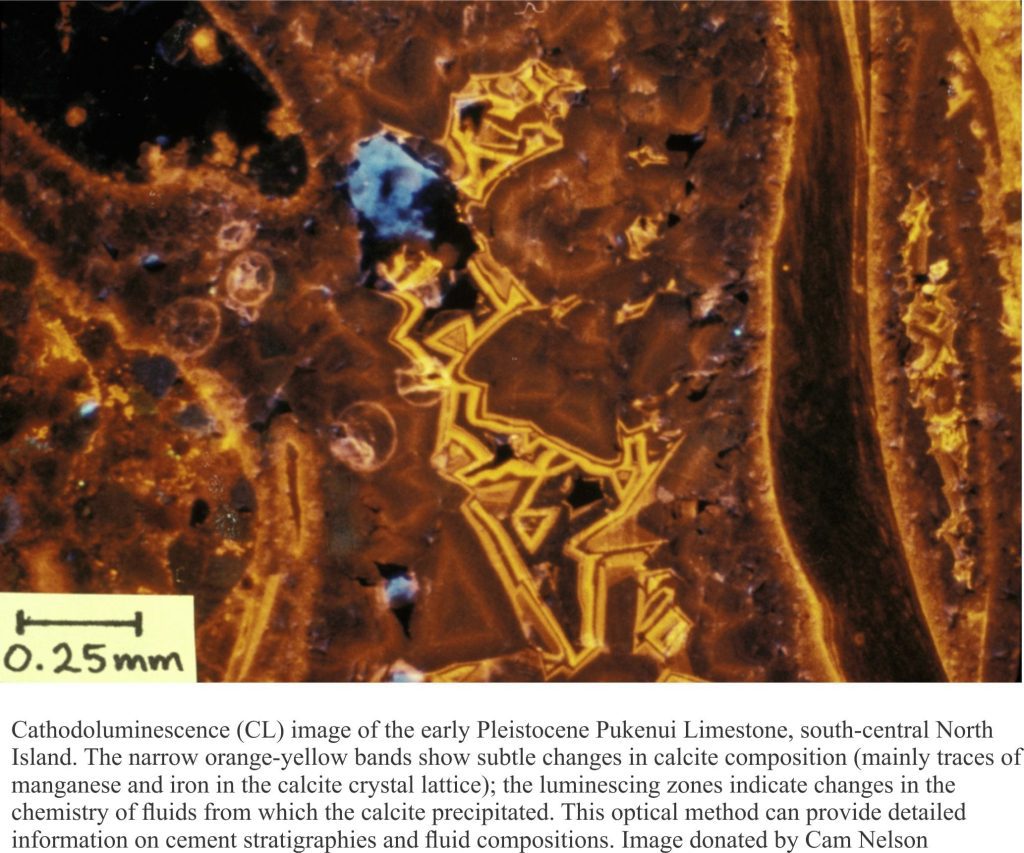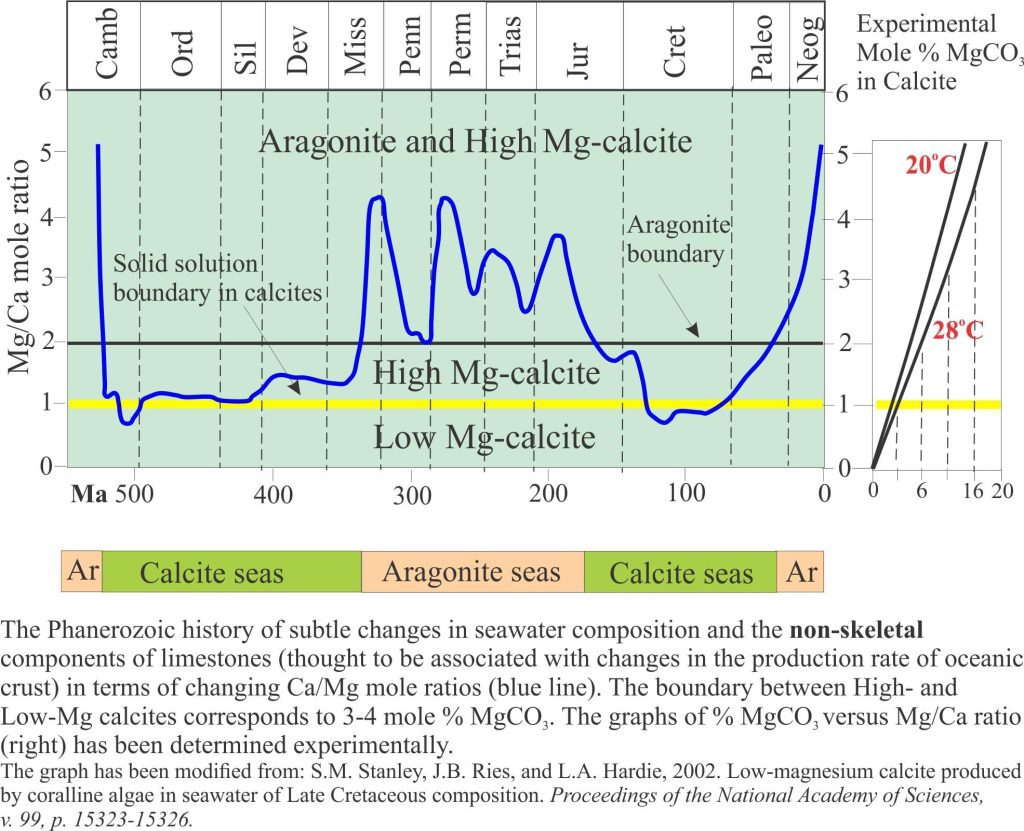This is the first of a How To…series… on carbonate rocks – the mineralogy of calcite, aragonite and dolomite.
If the arithmetic is correct, limestones and dolostones make up about 5-10% of sedimentary rocks in Earth’s crust. They host freshwater aquifers, mineral deposits, hydrocarbons, and some pretty spectacular landscapes (like caves and karst landforms). We treat carbonate rocks separately from sandstones for several reasons:
- Their framework components are primarily of biological origin, either directly as skeletal material or indirectly where organisms like algae and bacteria mediate carbonate mineral precipitation,
- All these critters inhabit the photic zone, The depth to which light penetrates is highly dependent on water turbidity. In clear water 50% of light is absorbed at one metre depth and 90% at 20m. There is little significant light below 200m depth. The photic zone is of critical importance for algae photosynthesis – algae are a primary food source for many invertebrates or join with them in symbiotic relationships.
- Carbonate chemistry is fundamentally different to the siliciclastics, and dominated by three minerals – calcite, aragonite, and dolomite,
- They tend to be chemically reactive at Earth’s surface and during all stages of burial,
- Limestones form at all latitudes, but the biomass responsible for their accumulations is most prolific in tropical and subtropical environs.
- Cementation of limestones begins at the sea floor and continues during burial. Original components like aragonite and high-magnesian calcite are usually replaced by calcite or dolomite during burial. In contrast, cementation of arenites does not begin until after burial.
- Oceanic limestones (like foraminiferal ooze) tend not to accumulate at depths greater than about 4000-5000m – the calcite-aragonite compensation depth.
Carbonate mineralogy: optical properties
Calcite:
- CaCO3
- Hexagonal crystal system.
- Crystals shapes are varied: commonly as rhomohedra and scalenohedra but can occur as clustered prismatic needles.
- Under Polarized light it has high birefringence and appears to twinkle as the microscope stage is rotated. Relief changes from high to low during stage rotation.
- Excellent rhombohedral cleavage.
- Twin lamellae are common and generally parallel or oblique to the long rhombohedral diagonal.
- Uniaxial negative.
- Sedimentary calcite can incorporate up to 19 mole% magnesium in its crystal lattice. High magnesian calcite has >5 mol% Mg; low magnesian calcite <5%. The magnesium content of skeletal calcite seems to fall into two groups; <5 mole %, and 11-19 mole %. Ferroan calcite has up to 2-3 mole% Fe2+. Common methods used to distinguish these various forms are noted below.
Aragonite:
- CaCO3. Can have up to 10,000 ppm strontium (high Sr is common in many recent corals, ooids and calcareous algae.
- Aragonite is a polymorph of calcite but belongs to the orthorhombic crystal system.
- Mostly commonly as acicular and fibrous cements in limestones, and a common component of invertebrate and protist skeletal material.
- High birefringence.
- Biaxial negative.
Dolomite:
- CaMg(CO3)2. The crystal lattice contains alternating layers of CaCO3 and MgCO3. Highly ordered dolomite contains equal amounts of Ca and Mg. Protodolomites, found in modern hypersaline lagoons and sabkhas, and recently discovered in some calcareous algae, have disordered crystal lattices (on XRD diffractograms) and less Mg.
- Hexagonal crystal system, usually as rhomobedra. Commonly seen as a replacement of calcite and aragonite, in some cases the original textures are preserved, and in others they are completely obliterated.
- Twinning less common. Twins parallel the short and long rhombohedral diagonals.
- Very high birefringence and usually very high relief.
- Uniaxial negative
Some popular methods for detecting and distinguishing dolomite and the polymorphs of calcite include:
Staining
Chemical staining of thin sections and rock slabs may seem a bit unsophisticated in an age where the technology for detailed analysis of mineral assemblages is readily available. But for the common carbonate minerals the method can be a very useful first pass at identification. The two stains in common use, Alizarin red-s (ARS) and Potassium ferricyanide (PF), are cheap and easy to use, even in the field where they may give an indication of stratigraphic trends in mineralogy, for example calcite/dolomite ratio, or changes in ferroan calcite. ARS is used to distinguish between calcite (stains pink-red) and dolomite (no stain). The intensity of blue PF stains in ferroan calcite increases with increasing Fe content; ferroan dolomite stains in green hues.
XRD
Diffraction peaks in an X-ray diffractogram measure the spacings between planes of atoms in a crystal lattice; they are referred to as d-spacings. A characteristic peak in Ca-Mg carbonates is the ‘104 peak’ that increases or decreases according to crystal chemistry. XRD measurement of the 104 peak is one of the more useful methods for identifying the magnesium content of calcites and identifying basic mineralogy in fine-grained deposits.
Cathodoluminescence
Pure calcite and dolomite do not luminesce when exposed to a high energy electron beam. However, certain impurities in the crystal lattice may become excited enough to luminesce, emitting light at visible wave lengths. The most common luminescence activator in carbonates is manganese (Mn2+), which emits orange-red to orange-yellow light. Manganese replaces calcium in the calcite lattice during precipitation. As little as 10-20 ppm Mn will activate luminescence. Note that iron (as Fe2+) will quench Mn luminescence if it is present in concentrations greater than a few 10s ppm. Iron as Fe3+, cobalt (Co2+) and nickel (Ni2+) will also quench Mn luminescence.
The amount of Mn2+ incorporated into the lattice will vary during diagenesis in concert with changes in the Mn2+ concentration of the interstitial fluids. This is commonly manifested as zoning in crystals, where the emission colours vary from one zone to another. Analysis of luminescence patterns in carbonate crystals can provide valuable clues about diagenetic history, particularly the evolution of cements, evolving fluid composition, and changes to rock porosity and permeability.
Changes in limestone composition through time
We tend to think of limestones as a Phanerozoic phenomenon – those fabulous Devonian, Carboniferous and Permian reefs and platforms. In fact, sedimentary carbonates accumulated across the last 3.5, perhaps even 4 billion years of Earth history. The Precambrian geological record is littered with extensive platform carbonates associated with stromatolite buildups. Most have been dolomitized but there is textural and geochemical evidence of them having been originally calcitic and aragonitic.
Production of skeletal and non-skeletal limestone during the Phanerozoic has not been steady and continuous but has fluctuated on a scale that reflects major changes in plate tectonics. Such grand scale cyclicity was recognised by Fred Mackenzie and John Morse (1992) who noted a tenuous coincidence between high sea levels and high rates of addition of new crust at mid-ocean spreading ridges, and low sea levels with low accretion rates. A burgeoning database now allows us to be more confident about this grand-scale cyclicity. We now know that the coupling of plate tectonics and sea level also produced changes in sea water composition, specifically the Mg/Ca ratio. High rates of accretion result in a lowering of the Mg/Ca ratio because Mg is removed from seawater and Ca is added during hydrothermal alteration of hot new crust. Geochemical experiments and theoretical analyses also tell us that seawater at low Mg/Ca ratios favours precipitation of calcite cements with low Mg content; many molluscs and modern corals also enjoy these conditions. The opposite, high Mg/Ca ratios, are more likely during low sea floor accretion rates (and low sea levels) and promote precipitation of high magnesian calcite and aragonite cements. High Mg/Ca ratios also favour critters like brachiopods, some extinct corals, modern echinoderms and calcareous algae. Thus, 1st-order low sea level cycles coupled with high Mg/Ca ratios tend to favour aragonite seas and high sea levels with low Mg/Ca ratios calcite seas.
The posts that follow in this carbonate series will deal with: the skeletal and non-skeletal frameworks of limestones, lime mud or micrite, limestone classification, reefs and platforms, cool water limestones, cementation, recrystallization and neomorphism, porosity and permeability – this will do for a start.
links to other posts in this series
Mineralogy of carbonates; skeletal grains
Mineralogy of carbonates; non-skeletal grains
Mineralogy of carbonates; lime mud
Mineralogy of carbonates; classification
Mineralogy of carbonates; carbonate factories
Mineralogy of carbonates; basic geochemistry






